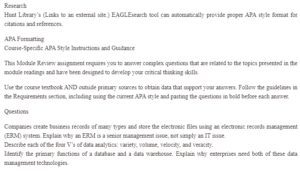Data Management-The Role of ERM and Data Analytics
Companies create business records of many types and store the electronic files using an electronic records management (ERM) system. Explain why an ERM is a senior management issue, not simply an IT issue.
ERM is a senior management issue because it is the responsibility of senior management to ensure that an organization’s records are accurate and complete (Mukred et al., 2019). ERMs can help organizations avoid litigation risks by ensuring that relevant records are properly stored and accessible. ERMs can help organizations improve their overall efficiency and productivity. Well-managed records can save time and money by reducing the need for manual search and retrieval processes. In addition, they can provide employees with quick and easy access to the information they need; when they need ERM, systems play a critical role in business continuity and disaster recovery planning (Turban et al., 2018). If a company’s records are destroyed or unavailable, it can significantly impact the business. It is the work of senior management to ensure that the company has a solid disaster recovery plan in place, including a reliable ERM system.
Describe each of the four V’s of data analytics: variety, volume, velocity, and veracity.
Variety refers to the different types of data that need to be analyzed. It can include text, images, video, and audio files. Volume refers to the large amount of data that needs to be processed (Turban et al., 2018). For instance, a company may need to analyze data from all its stores to decide inventory levels. Velocity refers to the speed at which data needs to be processed. For example, a company may need to make real-time decisions based on incoming customer data. Veracity refers to the accuracy and completeness of the data. Companies need to have confidence in the data they are using for decision-making.
Identify the primary functions of a database and a data warehouse. Explain why enterprises need both of these data management technologies.
A database is a collection of data that computers can access. A data warehouse is a data repository that can be used for decision-making. Enterprises need these technologies because they have different purposes (Hawash et al., 2020). Databases store operational data, such as customer orders and product information. Data warehouses store historical data, such as sales data and customer demographics. Enterprises need both operational and historical data to make informed decisions. Operational data can track real-time trends, while historical data can identify long-term patterns.
References
Hawash, B., Abuzawayda, Y. I., Mokhtar, U. A., Yusof, Z. M., Mukred, M., & Gaid, A. S. (2020). A conceptual framework for the adoption of electronic records management system in the Yemeni oil and gas sector. Test Engineering and Management, 83, 6528-6538.
Mukred, M., Yusof, Z. M., Noor, N. A. B. M., Kayode, B. K., & Al-Duais, R. (2019, September). The Role of Cloud Electronic Records Management System (ERMS) Technology in the Competency of Educational Institutions. In International Conference of Reliable Information and Communication Technology (pp. 936-946). Springer, Cham.
Turban, E., Pollard, C., & Wood, G. (2018). Information technology for management: On-demand strategies for performance, growth, and sustainability. John Wiley & Sons.
ORDER A PLAGIARISM-FREE PAPER HERE
We’ll write everything from scratch
Question 
Research
Hunt Library’s (Links to an external site.) EAGLEsearch tool can automatically provide proper APA style format for citations and references.

Data Management-The Role of ERM and Data Analytics
APA Formatting
Course-Specific APA Style Instructions and Guidance
This Module Review assignment requires you to answer complex questions that are related to the topics presented in the module readings and have been designed to develop your critical thinking skills.
Use the course textbook AND outside primary sources to obtain data that support your answers. Follow the guidelines in the Requirements section, including using the current APA style and pasting the questions in bold before each answer.
Questions
Companies create business records of many types and store the electronic files using an electronic records management (ERM) system. Explain why an ERM is a senior management issue, not simply an IT issue.
Describe each of the four V’s of data analytics: variety, volume, velocity, and veracity.
Identify the primary functions of a database and a data warehouse. Explain why enterprises need both of these data management technologies.